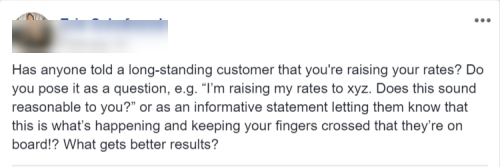One of the most common subjects freelancers discuss among themselves is how to move out of low-paying gigs. When you have established yourself and have a good pipeline of work, how do you raise your rate without losing those clients?
Raising freelance rates feels scary because it was such a slog for many of us to get to a position where we are making a living at all. Our current clients gave us our start we needed to get business rolling. Sometimes, though, those clients now take up more time than we can justify at those initial rates.
You don’t owe it to anyone to work for less you’re worth. If you want to get past that “making a living” stage and start to earn more as a freelancer, you’re going to have to go through this delicate situation.
In this article, we’re going to cover:
- the basics of setting your freelance rates.
- guidelines for raising them.
- a script for discussing this with your current clients.
- some alternatives to raising your rate.
If you raise your rate, are you okay with losing clients?
Consider this common scenario for experienced freelancers: You have four or five steady freelance clients all paying your current rate, and this adds up to you being pretty busy. You put in full days. During the weekends you worry about what’s not done. Occasionally you have to put in some time outside the regular workday when you would rather not.
If you are making less money than you would like to, this is a no-brainer. You need to raise your rate asap.
In fact, even if you are earning plenty, you should still be raising your rates in this situation just to free up time and to better prepare for next phase of your buiness.
But before you start the process, mentally rehearse the worst possible outcome — that long-time clients will go away mad.
Then reassure yourself that that is unlikely, because you are going to prepare to do this in a professional and courteous way.
Also reassure yourself that if the worst does happen you will survive it. You’re getting yourself in a position to find better clients and to make more money, and this painful episode would be necessary.
Then mentally rehearse the second worst outcome — that long-time clients don’t go away mad but that they do go away. They decide they can’t afford your new rate and you part amicably.
What will it mean for you if a current client decides they can’t afford your new fee?
On the one hand, something obviously negative will happen. You’ll take an X percent decrease in your current income.
On the other hand, you have now created an opportunity. You have taken back time that you can devote to strategy, learning and business development so you can go out and search for better paying clients.
The day you lose a client because your new freelance rate is too high for them is day one on the journey to a more sustainable and rewarding freelance career.
This brings up two basic principles that you need to keep in mind:
Principle 1 for setting freelance fees
If you are fully booked, you are charging too little. Raise your rates until you lose enough clients that you have time in your schedule to work smarter and to develop a plan to increase your income.
Principle 2 for setting freelance fees
Strategy is about a set of rules that decide what you don’t do. Therefore, pricing strategy is about knowing who you won’t work with.
Mentally rehearse the best-case scenario
Those worst-case scenarios above are actually not as likely as you fear. There is a very good chance that you’ll be surprised at how smoothly this goes down with clients when you follow the method below.
The reality is, most clients are going to be more okay with this than you realize.

I hear that all . . . the . . . time.
You’ll be surprised at how many clients get it and just get on with the work.
How to set your freelance rates before you start to raise them
We have developed a comprehensive formula for setting freelance rates that you can use yourself.
And then we developed an interactive freelance rates calculator based on that formula that lets you adjust the inputs yourself.
Freelance Rate Calculator: Know Your Expenses To Know Your Minimum
If you are like most freelancers, this formula will show you that you are charging less than half of what you should be. Most freelancers make the mistake of only charging for the client-facing time.
But, even though not all of your work is client facing, all of your actual costs must be passed on to clients.
Here are some of the actual costs that many freelancers leave out of their rates:
- The time they spend on managing their business
- The time they spend on business development
- The cost of holidays, vacations, sick days and personal days
- Marketing expenses
- Other overhead expenses
- The cost of health insurance
- Retirement savings
It’s important to keep in mind, we’re only talking so far about an hourly number that you use for your own estimates when you make proposals but that you don’t necessarily share.
For example, a rate of $100/hour doesn’t mean you go around telling clients that. You ultimately should be using project-based pricing, retainers or value pricing.
How much should your raise rates on current clients
This is less straightforward. While you may determine that your rates should be twice as high, a 100 percent increase on a current client is a tough sell.
In that situation, you probably will have to live with your current clients holding your average down while you start using your higher rate with new clients.
If you are in that situation, the goal is to find the outer limits of an aggressive but reasonable increase. Then use it to sort the clients you want to keep from the ones you can let go.
For example, let’s say you think a 25 percent increase on current clients is reasonable. Start with your least profitable client — the one who is sucking up more time than the contract warrants — and let them know about the increase. Then keep going until you have lost as many clients you can bear to lose, representing about a quarter of your income. You might never actually get to that point, because most of your clients accept the increase.
If absolutely everyone said yes, then your rates are obviously still way too low. Hire some subcontractors and pass some of these clients off to them, and then get to work on bringing in higher-paying clients.
Basic rules for raising your rates
The easier thing of course is to raise your rate on all your new clients and to leave your current clients alone. That’s a start, but it usually isn’t sufficient to transform your freelance business. These are some of the basic rules for raising your freelance fees on current clients.
- Aim for little variation between clients. But if there is variation, first money in gets the best deal. Last money in pays the highest rates.
- Never charge a new client less than an existing client.
- Never raise fees on an existing client and then lose your nerve and charge a new client the old fees.
- Once you have raised your rates on existing clients, that’s your new minimum for prospective clients — but not necessarily your floor. Keep naming higher numbers for new clients until you start to see that it’s not working.
- Give your clients plenty of time before raising rates.
- Don’t apologize, and don’t ask permission.
- Keep raising rates until you lose a client, and then reassess.
- Aim to have at least 20 percent of your time free for new business development.
Knowing your value is too simplistic
A lot of the advice about raising your rates tells you to argue from a position of knowing the value of your services. But that is too simplistic a way of thinking about it.
You have to know the value of your services to the client’s business. What is the impact of your services?
The best opportunity to get that is when you first start working with a client. As soon as you can, you should be asking:
- What are your business goals with this project?
- What will success look like?
- How will we measure the impact of this work?
Then during the project, follow up to ask about the actual results compared to those goals. If they said the goal was to increase leads or to convert more leads, ask them how that is going? Ask them to send you the monthly numbers that this project is being evaluated by, and participate in adjusting your services to get better results.
Then when it comes time to raise your rate, you can point to the value your work together is having. The conversation won’t have to get bogged down in the market rate for your services.
What not to say when you are raising your rates

Yikes. Definitely don’t say that. That’s an example of asking permission from your client to raise rates. This is a business decision you are making. They aren’t your boss, and they don’t make decisions about your business.
It’s okay to negotiate. But you negotiate from a conviction about what your new rates are. That begins after you announce your new rate and then only if they ask if there’s any wiggle room.
And then try to avoid negotiating on price. Instead negotiate on deliverables. When you negotiate on price, you are admitting your services are worth less. When you negotiate on deliverables, you let the client save face and stick to their budget while you maintain your own value.
Here’s an example of negotiating on deliverables in a hypothetical case of increasing your fees by a little more than 25 percent from $50/hour to $65/hour:
Client: Our budget won’t support that. Can you do it for $55 an hour instead?
Freelancer: I understand if you don’t have enough budget for these services. Until now you’ve been spending $2,000 per month for my work, and it sounds like you might be able to afford slightly more. For that budget, I can keep working with you, but I’ll need to limit what I do for you to XYZ going forward. Let’s maintain these essential activities. then when you have more budget we can talk about resuming the rest of the project.
If they go for that, then you’ve kept your actual income the same, but you’ve bought back 25 percent of the time you spend on that client, which you can now devote to new business development.
Another option is to say you can agree to that lower rate in return for a six-month commitment paid in advance.
Freelancer: This will allow me to hire some some support so I can provide you the service you expect more efficiently. If this is satisfactory to you, I’ll send the invoice right away, and with the payment we can start planning the next six months of work.
If they go for that, follow through. Hire a subcontractor, start training them to handle this client and start transforming your business into this more profitable model.
The script you should use when you talk to your clients about raising your rates
Here is the generic all-purpose script you should use with your current clients. It’s pretty simple.
Freelancer: I’m really enjoying our work together, and I look forward to getting even better results in the future. I need to let you know, however, that I have an opportunity to grow my business, so I’ll be raising my rates so that I can bring on more resources that will let me add to my client mix. To carry on with our current work, the new monthly fee for this package of services will be $___. I’ll postpone making this effective until ____ to give you time to adjust your budget if necessary. Please let me know if you have any questions.
Whether or not you do this by email or over the phone is fielder’s choice. They both have their place. My own instinct is that asking for a meeting to discuss this makes it feel too much like a really big deal. The mood to go for is, “just letting you know.” I think email suffices for that.
How much advance notice should you give?
First, consider from their perspective how much work is in-progress. If your services take a couple months to complete, definitely do not raise the rates on anything that is assigned and underway.
I recommend being excessively generous on the timeline.
Freelancer: I’ll invoice you this month and next at the current rate, and my new rates will be effective starting after the end of next month.
Another case when you might give a lot of warning is if you have a retainer agreement of X hours/month at $Y/hour. Retainers often are in effect for a full year, so from your client’s perspective, they’ve locked up your price for that year. I think you should honor that arrangement and start laying the foundation for a rate increase on this client at the end of the year.
Another situation where you might start the conversation pretty early is if you want to influence their budgeting process. It helps if you know your client’s fiscal year.
If it starts July 1, for example, then you know they may be submitting budgets to their own boss in May and June. If they value your services, give them a chance to advocate for the budget to keep using you. Give them a heads up a couple months ahead or more.
Freelancer: Hi. I think you mentioned that your budget year starts July 1. On our next check-in call can talk about what your needs for my services will be next year?
Hopefully they say they have big plans to use your services a lot more. In any case, that’s the time to let them know they’ll need to budget more for your higher rate.
Goodbye is not forever
If this really a freelance career you’re working on, you’ll find that anything can happen given enough time. Even lost clients may not be lost for good.
Personally, I’ve had one client “fire” me twice over rates before returning later and another who has come around to me once.

That was nice to hear.
And I got essentially two of these from this client over a couple of years.

You know what they tried? The first time it was a “full-service agency” that provided the equivalent of my services as an add-on to comprehensive contract for little added cost. If you work in marketing, you can probably guess how effective the full-service agency was. The second time is was a freelancer working for cheaper rates.
Neither route worked out like they had hoped. As we’ve said over and over, it helps to have a niche.
Collectively, these boomerang clients have been worth about $120,000 in revenue to me over a two-year period.
2 alternatives to raising your freelance rate
I’m ambivalent about including this section, because I don’t think you should give yourself an out. If you aren’t making enough money as a freelancer, you need to be brave and get down to the business of raising your rates.
But if you can’t bear the prospect of losing clients, here are three alternative approaches to consider that may help you increase your income incrementally.
1. Upsell your clients on new services
Matt Keener, president of Keener Marketing Solutions, says a message that rates are increasing is one of the 5 Truths It Rarely Helps to Tell Your Client. Your clients tend toward the status quo.
I think this concern can be exaggerated. Your clients are in business themselves and with the right communication on your end, they will understand, especially if you understand the value of your services to their business results and actually deliver that value.
But if you think they won’t be open to any discussion of higher rates — and if you really can’t lose them — then Keener suggests creatively proposing new upsell services to these patrons.
For example, if you have been selling hourly services, maybe now is the time to sell:
- a social media marketing plan if you are a freelance copywriter.
- a SEO audit if you are a web developer.
- a one-time design refresh of all the assets that predate your work if you are a graphic designer.
- a basic chatbot integration for their sales landing pages if you are a WordPress developer.
- anything strategy or planning related that helps clients make decisions about the future.
Obviously some bare-bones clients are not looking for any additional services and don’t want to plan for the future. If this is the case you need to ask yourself if the work you are doing for them is sustainable.
2. Change your pricing structure
You can propose a change of compensation structure to these clients. Some of your legacy customers are happy to pay more to get more but just need the options presented to them in a way that feels attentive to their needs and concerns.
One way to do this is to tell these longstanding clients that you are now offering services in a monthly package format. For $1000, or whatever you believe is reasonable, offer your basic service, which includes the work you generally do for them. Then you can be available for additional work at your new hourly rate.
For example, you can give them 10 hours/month at a fixed fee “discounted” to your old rate and then any overages or extras at the new rate.
If the projects you’re working on are successful, then they will need you more and an increasing share of your total time will be billed at the higher rate.
How to say goodbye when it’s just not going to work
In general I recommend not just cutting a client loose on the basis of price alone. (If they aren’t a good fit for you otherwise, then, yes, definitely fire clients.) Instead, as we’ve been discussing, propose a rate that would make working with this client worth it and let them bow out if they can’t afford it.
But sometimes you want to cut to the chase.
For example, the client may say they can’t afford the new rate without but they never explicitly say no. The ball is now in your court, the current contract is about to end and you don’t see any value in negotiating with them.
It’s time to bow out gracefully. Do not tell lash out here. Remember the examples I gave above of boomerang clients when things end amicably.
Senior editor of The Billfold and full-time freelance writer Nicole Dieker gives a great example of how to do this with professional tact in a Contently blog post.
Freelancer: “I wanted to let you know that I am moving on to other opportunities. I plan to complete all of our outstanding assignments including X, Y, and Z, and our last day of work together will be . . . .”
Leave your clients set up for success
A really smart move at this point is to recommend other people in your network to that client. I had a one-year relationship wind down partly over the budget once, and I spent the last month making sure to establish colleagues with that client who were earlier in their careers and could consider their low rates.
My network is valuable, but withholding it from that client wasn’t in anyone’s interest. The managers there were grateful for the hand off, my freelance colleagues appreciated it, and now a couple years later, when we’ve all gone on to other jobs, we’re all still friends and recommending work to one another.
In many ways this isn’t the end of the relationship so much as an opportunity to strengthen it in new ways. Keep the exchange dignified and do all you can to uphold your obligations as you phase yourself out.
More about setting rates and working with clients
- Getting the Freelance Rate You Deserve
- 5 Biggest Things You’re Forgetting in Your Freelance Rates
- How To Charge a Rush Fee For Freelance Clients Without The Drama
- The Path To Higher Paying Clients – Insights From the Marketing Mentor
- How To Salvage a Bad Client Relationship

Robert McGuire
Publisher of Nation1099
Robert McGuire is the owner of McGuire Editorial, a content marketing services firm specializing in B2B and tech startups.





